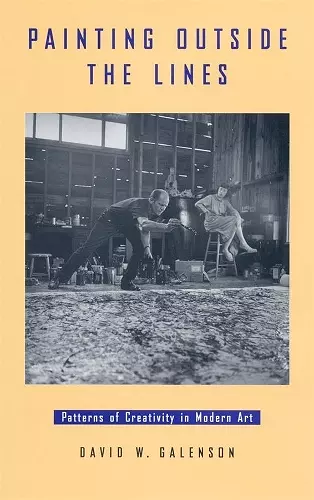Painting outside the Lines
Patterns of Creativity in Modern Art
Format:Hardback
Publisher:Harvard University Press
Published:17th Feb '02
Currently unavailable, and unfortunately no date known when it will be back

Why have some great modern artists—including Picasso—produced their most important work early in their careers while others—like Cézanne—have done theirs late in life? In a work that brings new insights, and new dimensions, to the history of modern art, David Galenson examines the careers of more than 100 modern painters to disclose a fascinating relationship between age and artistic creativity.
Galenson’s analysis of the careers of figures such as Monet, Seurat, Matisse, Pollock, and Jasper Johns reveals two very different methods by which artists have made innovations, each associated with a very different pattern of discovery over the life cycle. Experimental innovators, like Cézanne, work by trial and error, and arrive at their most important contributions gradually. In contrast, Picasso and other conceptual innovators make sudden breakthroughs by formulating new ideas. Consequently, experimental innovators usually make their discoveries late in their lives, whereas conceptual innovators typically peak at an early age.
A novel contribution to the history of modern art, both in method and in substance, Painting outside the Lines offers an enlightening glimpse into the relationship between the working methods and the life cycles of modern artists. The book’s explicit use of simple but powerful quantitative techniques allows for systematic generalization about large numbers of artists—and illuminates significant but little understood features of the history of modern art. Pointing to a new and richer understanding of that history, from Impressionism to Abstract Expressionism and beyond, Galenson’s work also has broad implications for future attempts to understand the nature of human creativity in general.
In Painting outside the Lines, David Galenson offers the simple but fascinating thesis that statistical analysis reveals patterns in the careers of modern artists. The book's most startling argument describes two kinds of artistic behavior enacted by modern artists since the impressionists: the conceptualists, whose work matures early, and the experimentalists, whose work comes to fruition late. What Galenson has to say about innovation and the pressure it exerts on the behavior of artists in the modern world has often been observed. This, however, is the first time that it has been quantitatively studied, putting common sense knowledge on an altogether different foundation. Galenson has written a book whose methods and results ought to be debated and worked through by the largest public possible, extending far beyond either economics or art history. By leading to a host of other questions and other insights, Painting outside the Lines accomplishes what the very best scholarship ought to do. It is not an end, a summing up, but the beginning of what I hope will be a whole new way of thinking about the discipline of art history. -- Robert Jensen, author of Marketing Modernism in Fin de Siècle Europe
Painting outside the Lines represents the effort of a quantitative economic historian to contribute to our understanding of the evolution of modern visual art. This research will get attention--indeed, it already has--for establishing the fact that the most esteemed work of artists, reflected in the prices their works command at auction, has been coming at earlier and earlier ages. Deeper and more important than that astonishing fact is what the study uncovers about the process of artistic innovation. Two technologies vie for the achievement of innovation: the experimental and the conceptual. Both are viable, and the one that dominates in a particular school or movement depends on the circumstances at hand. This quantitative study is well and thoroughly executed. -- Richard Caves, author of Creative Industries: Contracts between Art and Commerce
ISBN: 9780674006126
Dimensions: unknown
Weight: 558g
272 pages